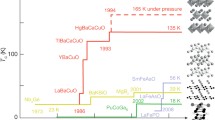Summary
Macroscopic theory of superconductivity valid for magnetic fields of arbitrary magnitude and the behaviour of superconductors in weak high frequency fields are discussed. The problem of formulating a microscopic theory of superconductivity is also considered.
Riassunto
Si discute una teoria macroscopica della superconduttività valida per campi magnetici di intensità arbitraria e il comportamento dei superconduttori in campi deboli di alta frequenza. Si considera altresì il problema della formulazione di una teoria microscopica della superconduttività.
Similar content being viewed by others
References
F. London:Superfluids, vol. I (1950).
V. L. Ginzburg andL. D. Landau:Žu. Eksper. Teor. Fiz.,20, 1064 (1950).
V. L. Ginzburg:Usp. Fiz. Nauk,42, 169, 333 (1950). Translation inAbhandlungen aus der sowjetischen Physik, Folge II (Berlin, 1951), p. 135.
V. L. Ginzburg:Dokl. Akad. Nauk SSSR,83, 385 (1952).
V. P. Silin:Žu. Eksper. Teor. Fiz.,21, 1330 (1951).
V. L. Ginzburg:Žu. Eksper. Teor. Fiz.,23, 236 (1952).
A. A. Abrikosov:Dokl. Akad. Nauk SSSR,86, 489 (1952).
A. V. Gurevič:Žu. Eksper. Teor. Fiz.,27, 195 (1954).
V. L. Ginzburg:Žu. Eksper. Teor. Fiz.,29, n. 4 (1955).
L. D. Landau andE. M. Lifšic:Statistical Physics (Moscow, 1951), chap. XIV.
V. L. Ginzburg:Journ. of Phys. USSR,10, 107 (1946);Žu. Eksper. Teor. Fiz.,17, 883 (1947);19, 36 (1949);Usp. Fiz. Nauk,38, 490 (1949).
The condition (11) automatically follows from the variation principle if no auxiliary conditions restricts ψ on the boundary: that is the case considered here (2).
J. Bardeen:Phys. Rev.,94, 554 (1954).
The casex≪1 is being considered here; about corrections containingx see (8). Forx → 0 in the film ψ=ψ0=const, i.e. ψ is independent ofz.
N. V. Zavarickij:Dokl. Akad. Nauk SSSR,78, 665 (1951);85, 749 (1952).
A. B. Pippard:Proc. Roy. Soc., A.216, 547 (1953);Physica,19, 765 (1953).
D. Shoenberg:Superconductivity (Cambridge, 1952).
M. S. Hajkin:Žu. Eksper. Teor. Fiz.,28, 115 (1955).
V. L. Ginzburg:Žu. Eksper. Teor. Fiz.,21, 979 (1951).
A. A. Abrikosov:Dokl. Akad. Nauk SSSR,86, 43 (1952).
The relation (34) can be obtained from experimental facts even without verifying the validity of equation (1) from which the expression (34) follows directly (see (4) and (29)).
V. L. Ginzburg andG. P. Motulevič:Usp. Fiz. Nauk,55, 469 (1955).
According to (20). for tinλ c<0.83 cm; measurements for lower wave lengths and for other metals are not available although the corresponding experiments are quite possible and their importance was emphasized over 10 years ago (see (21)).
E. Fawcett:Proc. Phys. Soc., A66, 1071 (1953).
V. L. Ginzburg:Žu. Eksper. Teor. Fiz.,14, 134 (1944).
V. L. Ginzburg:Usp. Fiz. Nauk,48, 25 (1952); Translation inFortschritte der Physik (Berlin),1, 101 (1953).
H. Koppe:Erg. der exakten Naturwiss.,23, 283 (1950).
M. R. Schafroth:Phys. Rev.,96, 1149, 1442 (1954).
H. Fröhlich:Phys. Rev.,79, 845 (1950);Proc. Phys. Soc., A64, 129 (1951).
J. Bardeen:Rev. Mod. Phys.,23, 261 (1951).
M. R. Schafroth:Helv. Phys. Acta,24, 667 (1951);Nuovo Cimento,9, 291 (1952).
An exclusion in this respect is the investigation ofH. Fröhlich:Proc. Roy. Soc.,223, 296 (1954) in which, however, only the one-dimensional case is considered.
W. S. Corak, B. B. Goodman, G. B. Satterthwaite andA. Wexler:Phys. Rev.,96, 1442 (1954).
L. D. Landau:Journ. of Phys. USSR,5, 71 (1941);11, 91 (1947).
Author information
Authors and Affiliations
Additional information
In the transliteration of Russian names we follow the International System of Transliteration of Cyrillic Characters (2nd Draft Iso Recommendation no. 6, 1954), published at pag. 388 of the no. 4 of the =Supplemento to Vol.1 (1955) ofIl Nuovo Cimento.
Rights and permissions
About this article
Cite this article
Ginzburg, V.L. On the theory of superconductivity. Nuovo Cim 2, 1234–1250 (1955). https://doi.org/10.1007/BF02731579
Received:
Published:
Issue Date:
DOI: https://doi.org/10.1007/BF02731579



